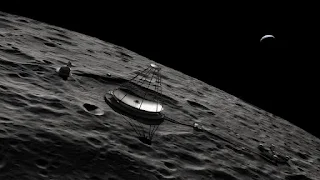-
An international team of astronomers used data collected by the ROLSES telescope mounted on the US Odysseus lunar probe to make the first radio astronomical observations from the lunar surface.
An international team of astronomers used data collected by the ROLSES telescope mounted on the US Odysseus lunar probe to make the first radio astronomical observations from the lunar surface.
The press service of the American University of Colorado quoted university professor Jack Burns as saying: “Experts from Intuitive Machines achieved the impossible when they were able to deploy our antennas in difficult conditions for the Odysseus probe to land, collect data and send it to Earth. Thanks to that data, we took a look at Earth. “It was as if it were another planet orbiting a distant star.”
As Professor Burns pointed out, this experiment marked the beginning of the era of lunar radio astronomy. The experiment was conducted aboard the Odysseus probe, which landed on the surface of the moon under emergency conditions in February 2024 as part of the IM-1 mission, which is part of the NASA Commercial Lunar Payload Services program for developing means of transporting payloads to the moon’s orbit and surface by private companies.
It is noteworthy that the Odysseus probe is the first American probe that was able to land on the surface of the moon, since December 1972, but its landing on the surface of the moon did not occur as expected. During its contact with the surface of the moon, one of the “legs” of the landing module broke, causing it to fall on its side.
This incident, according to Professor Burns, allowed scientists to implement part of the "Odysseus" scientific program, since the unsuccessful landing of the probe prevented it from deploying the rest of the devices. Using this part of the ROLSES antenna, astronomers monitored radio waves emanating from Earth in a very wide range of frequencies for an hour and a half.
It is noteworthy that the previous experiment of this kind, as the researchers pointed out, was conducted in 1990 in outer space on board the “Galileo” probe during its trip to Jupiter, but “Rollsys” was able to obtain much more data from observations from the surface of the moon. According to Professor Burns, this success convinced NASA to support the remanufacturing of the ROLSES telescope, which will be sent to the moon in 2026 as part of one of the subsequent CLPS missions.






Intriguing.
ReplyDelete